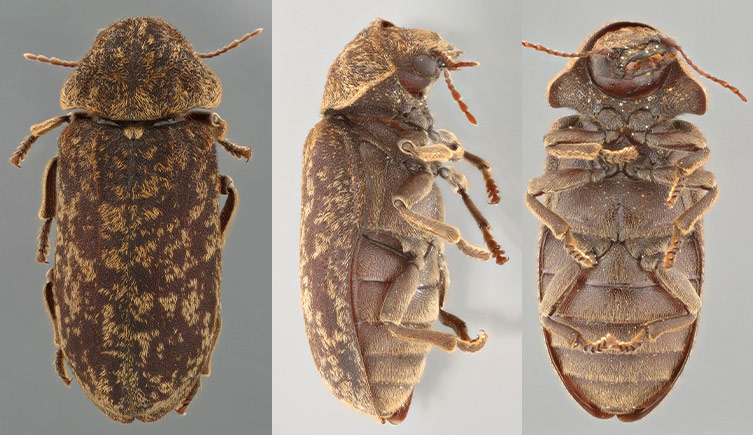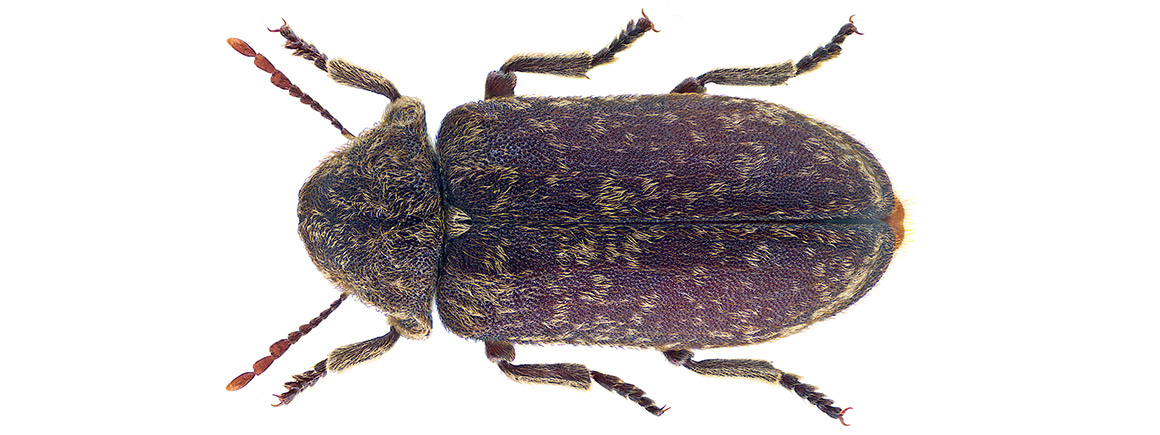The death watch beetle (Xestobium rufovillosum) is a wood boring beetle within the family Anobiidae. This species is well known for being a pest species - the larvae feed on deadwood in their natural habitat and when introduced to a home they feed on wooden items.
Identification
There are three species in the genus Xestobium in central Europe with the death watch beetle being the one representative species in England. The beetle ranges from 5-9 mm in length. They have cylindrical bodies and head which is characteristic of a wood boring species. The top part of the thorax (the beetle's mid-section) usually covers the head when viewed from above the beetle.
Possible confusion
The common furniture beetle (Anobium punctatum) can be confused for the death watch beetle. The common furniture beetle is smaller and has longitudinal rows of pits on its elytra (the beetle's wingcases), which the death watch beetle lacks. Adult death watch beetles also produce a characteristic tapping and ticking sound inside the wood they infest.
Distribution and habitat
The death watch beetle is common and widespread in the south of England. Outdoors it can be found in the deadwood of trees. Indoors, it can be a pest of furniture and structural timber.
Life cycle
During spring the adults can be commonly found in wood and deadwood. Females lay their eggs into small holes in wood or in trees. The larvae then develop inside the wood, tunneling in the wood as they feed until they begin to pupate in a pupation chamber. After pupation the adult beetle tunnels out of the wood, where they leave characteristic exit holes which can be useful in determining their presence.
The length of time to complete a life cycle in this species varies, some individuals have been reported to take over 4-5 years, whereas others have completed their life cycle in one year.
Signs of an infestation
Holes in wood are the most likely piece of evidence to suggest an infestation: the holes and tunnels are circular and around 3mm in diameter. The larvae produce distinctive small bun-like pellets of faeces (frass) which you might spot around the holes.
Prevention and Control
Avoid the introduction of decayed or damaged wood into the home. For smaller infested items, freezing can be productive.

The adult death watch beetle. The beetle is dark brown with golden hairs giving it a mottled pattern. The adult beetle has a body length of 5-9 mm. © Malcolm Storey (CC BY-NC-SA 4.0) via BioImages. Composite of three images.
More information
Download this information on the death watch beetle as a PDF (223KB)
Elsewhere on the internet:
Common insect pest species in homes
Back to the Common Insect Pest Species in Homes guide

Identify your finds 🔍
Need help in indentifying what you've seen?
Our ID guides and expert team are here to assist you.

Don't miss a thing
Receive email updates about our news, science, exhibitions, events, products, services and fundraising activities. We may occasionally include third-party content from our corporate partners and other museums. We will not share your personal details with these third parties. You must be over the age of 13. Privacy notice.
Follow us on social media